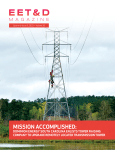According to research firm Counterpoint, first-quarter 2023 Electric Vehicle (EV) sales in the U.S. showed a 79% year-over-year increase -moving the U.S. into the number two market position worldwide. As more EVs pop up in driveways across the country, there is a prime opportunity to reframe how utilities think about the interaction between customers and the grid that powers their lives.
When someone buys an EV, they most likely don’t engage their utility in that decision-making process. However, as more customers start driving electric every day, it becomes even more critical for utilities across the country to have better insight into the EVs in their territory. With the impact they can have on the health of a utility’s network, their place in the grid must move from the grid edge to the center of the utility’s operations. In this new operating model, the relationship between utility and customer, between customer engagement and demand management, can no longer be approached separately. Optimization of the customer journey and the grid must be synchronized.
Additional benefits come through capturing the decarbonization benefits EV-focused programs can have to net-zero emission goals. A report by The Brattle Group found that by 2040, actions by customers can reduce nearly two times more greenhouse gas (GHG) emissions than would result from current policies to promote investments in clean energy supply alone. For EVs, the increased contribution to carbon reduction will come in large part due to the industry expecting a fourfold increase in the total number of EVs on the road from 2030 to 2040, as well as anticipated declines in grid emissions.
Keys to moving forward
For utilities to succeed in EV management, a comprehensive strategy is essential. The payoffs for this strategy can come in longer-term goals that focus on opportunities to upsell EV customers with targeted rates and offers and leverage those loads as part of Distributed Energy Resource (DER) profiling. However, before utilities set their sights on too many exits down the road, the critical first part of the journey is ensuring EV programs are thorough and accurate for the best chance of success. Three key elements that can help a utility navigate the adoption cycle include:
Adoption: Utilities should also consider playing a more active role in educating customers on the benefits of EV ownership from both an environmental and cost perspective. As utilities look for new revenue opportunities, EV education and associated services are a great place to focus. Proactive outreach is paramount. Utilities should start to offer or expand the use of EV cost calculators, car comparisons and other incentives to drive adoption.
Identification: Tapping deep machine learning, utilities can identify the presence of an EV, show the time and frequency of charging and disaggregate the energy being consumed from the vehicle with advanced metering infrastructure (AMI) data. With highly trained algorithms, this machine-learning insight can pinpoint things that remain indistinguishable to the human eye. For instance, a newly installed pool pump may make a whole-home load curve look astonishingly similar to that of an EV owner, but data science can’t be so easily fooled. Machine learning algorithms can identify the signatures that make the EV load unique and help isolate only that load.
Proactive engagement: Utilities can make engagement intuitive and empower customers for essential digital self-service (DSS) transactions, such as bill payments, autopay, payment arrangements, paperless billing, utility program enrollment, usage inquiries and communications. DSS helps utility customers prioritize what they care about most and encourage them to take the right action at the right moment. Highly effective proactive communications include high-bill alerts that provide personalized energy insights, energy efficiency tips and program promotions to help them save and weekly energy reports that provide day-by-day energy benchmarking and help customers answer billing questions without contacting the call center.
Rhode Island Energy: Changing how we think about behavioral programs
Electric utilities such as Rhode Island Energy already are factoring in these developments. The company has long worked together with customers to lower their energy use and bills while also reducing demand on the grid. A deeper look at their EV initiatives shows the many benefits they have achieved for customers.
Successfully transitioning to net-zero emissions requires, in part, increased adoption of EVs and better managing the entire EV process to also avoid negative grid impacts. Rhode Island Energy actively works to provide customers with the information and tools necessary to flex their energy use, such as EV charging, to off-peak hours. Recognizing the role of electrification, they also are making it easier for customers to electrify things like transportation and heating using high-efficiency heat pumps.
Rhode Island Energy already offered a rebate to encourage EV load shifting to off-peak hours. While successful, the enormity of this challenge requires the testing of many different approaches.
“We’ve focused for a long time on running behavioral energy efficiency programs that get the attention of busy customers and influence them to act,” said Ryan Cote, EV Program Manager for Rhode Island Energy. “Based on our success using behavioral science and personalized outreach, we wanted to see if the same principles could be applied to changing electric vehicle charging behavior.”
This is absolutely the right line of thinking. Behavioral programs are about so much more than neighbor comparisons and home energy reports. They are about clarifying and influencing increasingly complex customer actions. We know that electrification is critical to decarbonization, and electrification largely depends on customers taking action, so it’s not something utilities can accomplish without the customer. Behavioral strategies are the perfect approach.
Using behavioral science techniques to shift EV charging load
Rhode Island Energy conducted a digital engagement campaign that educated customers on the impact of charging their vehicles at different times of the day, and it was successful in customers changing their behavior in the ways needed to better manage the grid. Email was chosen as the communications vehicle of choice using effective behavioral science tools. Key examples included:
Personalization and gamification – Rhode Island Energy made it fun for customers to compete with themselves. In the case of this campaign, customers were shown how their charging habits changed month-over-month with rich data visualizations right in their email inboxes.
Unity and agency – Customers were reminded that they have the power to have an impact, and when they do it as part of a big group, it feels good and makes a big difference.
Benefits framing – A totally different type of motivator that showed customers what’s in it for them if they take an action. In this case, it was the rebate they received by charging at off-peak times.
Salience – Rhode Island Energy made it easy for a customer to act by showing them the one action that’s most relevant to them. Throughout the campaign, the next best actions relevant to EV drivers were included. Examples included learning where public chargers are available around town, the tangible benefit of upgrading to a level 2 charger and setting an automated off-peak charging schedule, with advice specific to their EV model.
Ease – The decision to act was made to feel effortless. For example, an option was included for a one-tap download of the PlugShare app, which helps customers locate the public charging sites mentioned above.
Achievement – Rhode Island Energy associated a feeling of pride with actions taken and created a sense of anticipation of taking similar actions in the future. By showing customers how much they could save from changing their charging habits, the utility positively reinforced that behavior and increased the likelihood that they will maintain those actions going forward.
Eye-opening program results
The accomplishments of the program were incredibly promising. It takes a wide variety of behavioral science techniques to measurably change energy consumer behavior. While this may seem like a lot of work and thinking for an email campaign, the initial results show the effort was worthwhile.
Following a 17-month campaign, analysis showed the emails had a whopping 77% open rate in some months, which is 3.7X the average for the utility industry, and an 18% click-through rate, which is 7X the industry average. And, the customers receiving the emails acted on the insights. Rhode Island Energy saw a nearly 10% reduction in on-peak EV charging among study participants. These findings were validated by trusted third-party evaluator DNV, who in their own study found that treatment customers have shifted the start of more of their charging sessions to off-peak periods.
These results speak to the power of behavioral science techniques in influencing the increasingly complex customer actions that are critical to decarbonization. In fact, there’s reason to believe this behavioral strategy could be even more effective at shifting load in other circumstances, as Rhode Island Energy had already worked hard to reduce the on-peak charging from this group of EV owners with previous efforts.
It’s time to charge ahead
These EV adoption efforts from Rhode Island Energy show what’s possible when utilities prioritize synchronizing relationships with their customers. As more EVs hit the roads — and electric grids — in increasingly higher numbers over the next decade, it’s up to the rest of the ecosystem to charge ahead. By doing so, we can collectively help drive results in the right direction in invaluable ways, including grid reliability, energy savings and sustainability and personalized customer engagement. The stakes have never been higher, and the keys are in all our hands.

Paul McDonald is a senior director of product strategy for Opower (part of Oracle Energy and Water). He joined Oracle along with Opower, where he previously served in leadership roles in client success, operations, product and solution architecture. Before joining Opower, McDonald consulted cabinet-level federal agencies on their international financial systems and operations. He is a graduate of the University of Notre Dame, where he received a B.S. in computer engineering.







